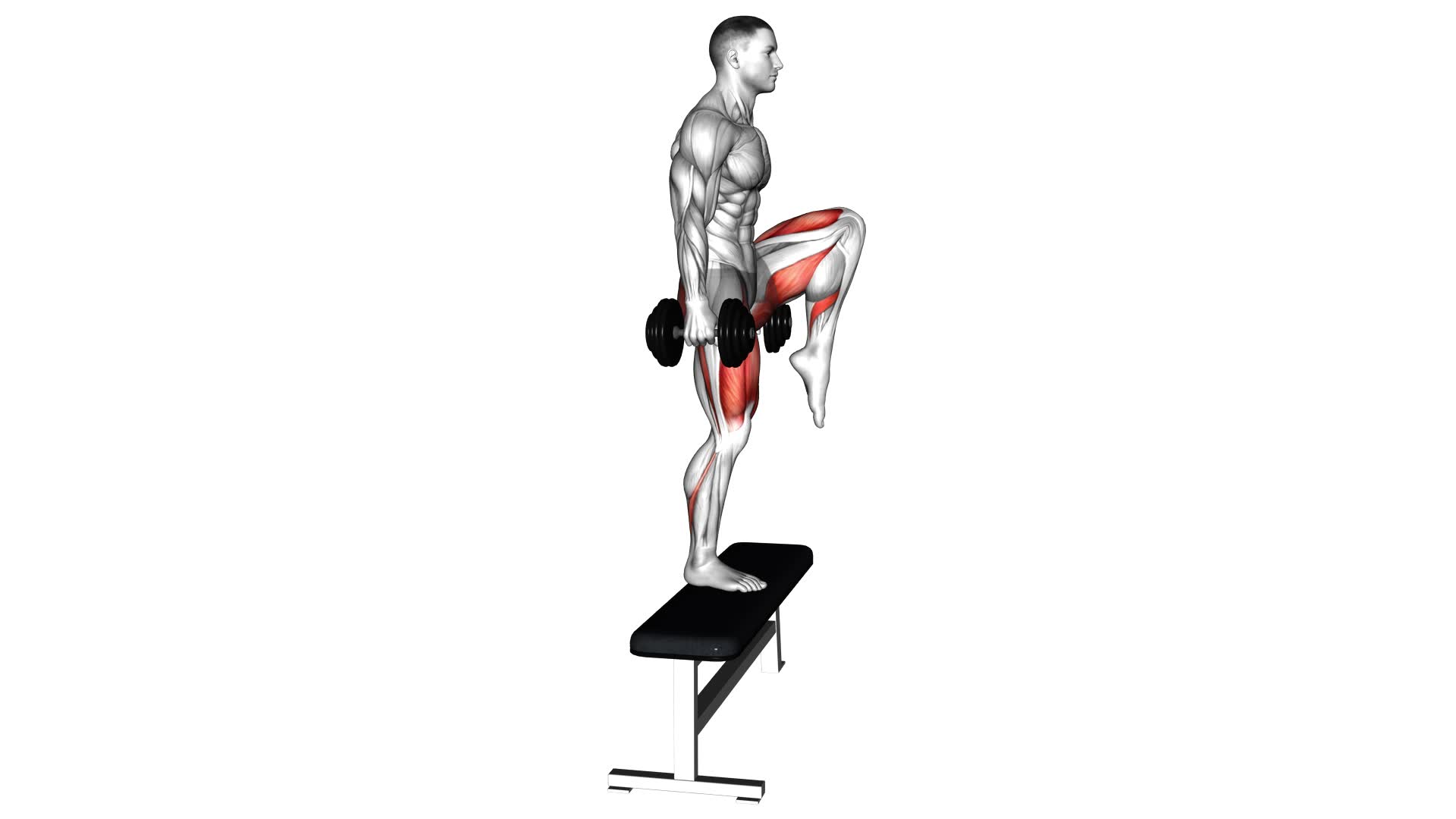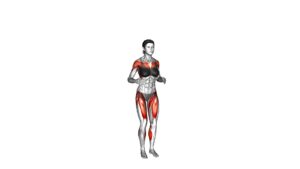Dumbbell Step-Up With Knee Raise – Video Exercise Guide & Tips

Are you looking for a quick and effective way to strengthen your legs and core? Look no further than the dumbbell step-up with knee raise!
Watch This Exercise Video
This exercise targets multiple muscle groups while also challenging your balance and stability.
In this video exercise guide, we'll show you the proper form and technique, as well as provide tips and variations to help you progress and avoid common mistakes.
Get ready to take your workout to the next level!
Key Takeaways
- Dumbbell Step-Up with Knee Raise targets multiple muscle groups simultaneously.
- Maintaining proper form and technique is crucial for maximizing results and preventing injury.
- Progression can be achieved by increasing resistance, trying advanced variations, and incorporating plyometric step-ups.
- Paying attention to nutrition and recovery is important for enhanced results and overall well-being.
Benefits of the Dumbbell Step-Up With Knee Raise
You can experience numerous benefits by incorporating the dumbbell step-up with knee raise into your workout routine. This exercise isn't only effective but also versatile, allowing you to target multiple muscle groups simultaneously. One of the key benefits of this exercise is the improvement in balance it provides. By stepping up onto a raised platform while holding dumbbells, you challenge your body to maintain stability and control. This helps to strengthen your core muscles, which are responsible for maintaining balance and stability throughout your body.
Targeting your core muscles is another major advantage of the dumbbell step-up with knee raise. As you lift your knee towards your chest, you engage your abdominal muscles, obliques, and lower back. This not only helps to improve your overall core strength but also enhances your posture and stability. Additionally, by using dumbbells during this exercise, you add resistance, which further intensifies the workout for your core muscles.
Incorporating the dumbbell step-up with knee raise into your workout routine is a great way to improve your balance and target your core muscles. By challenging your body in this way, you can enhance your overall strength, stability, and posture. So, grab your dumbbells and step up to the challenge!
Proper Form and Technique for the Exercise
To perform the dumbbell step-up with knee raise with proper form and technique, it's important to maintain a stable and controlled movement throughout the exercise. This exercise primarily targets your quadriceps, hamstrings, glutes, and calves. However, if not done correctly, you may not fully engage these muscle groups and risk injury.
One common error is rushing through the movement. Take your time and focus on each step. Start by standing in front of a bench or step with a dumbbell in each hand. Step up onto the bench with your right foot, pushing through your heel. As you straighten your right leg, bring your left knee up towards your chest. Slowly lower your left foot back to the ground and repeat on the other side.
Another common mistake is using too much momentum. Remember, it's about control, not speed. Avoid swinging your leg or using your back to lift yourself up. Instead, rely on the strength of your legs to perform the movement.
Lastly, make sure to maintain proper posture throughout the exercise. Keep your chest up, shoulders back, and core engaged. This will help you maintain balance and stability.
Equipment and Dumbbell Selection
Maintaining proper form and technique for the dumbbell step-up with knee raise requires the use of appropriate equipment and careful selection of dumbbells.
When it comes to equipment, you'll need a step-up platform that's sturdy and stable. Look for a platform that's about knee height, as this will allow you to step up comfortably and safely. Make sure the platform has a non-slip surface to prevent any accidents or injuries.
Now let's talk about dumbbell selection. The weight of the dumbbells you choose will depend on your fitness level and strength. It's important to challenge yourself, but also to not overdo it. Start with lighter dumbbells and gradually increase the weight as you become more comfortable with the exercise. Remember, it's better to start off light and work your way up than to risk injury by using weights that are too heavy.
When selecting dumbbells, opt for ones that have a comfortable grip and are easy to hold. This will ensure that you can maintain proper form throughout the exercise. Additionally, make sure that the dumbbells are securely fastened, so they don't slip out of your hands during the workout.
Variations and Progressions to Challenge Yourself
Looking to take your dumbbell step-ups to the next level? There are advanced variations that can challenge your muscles and enhance your overall strength and stability.
One way to progress is by increasing the resistance by using heavier dumbbells or adding ankle weights. These variations and progressions won't only push your limits but also help you reach your fitness goals faster.
Advanced Step-Up Variations
Challenge yourself by incorporating advanced step-up variations into your workout routine. These variations won't only add a new level of difficulty to your exercises but also help you target different muscles and improve your overall strength and stability.
Here are three advanced step-up variations to try:
- Weighted Step Ups: Hold a pair of dumbbells or a weighted vest while performing the step-ups. This will increase the resistance and make your muscles work harder, resulting in greater gains.
- Single Leg Step Ups: Instead of using both legs, perform the step-ups using only one leg at a time. This variation will challenge your balance, stability, and leg strength.
- Plyometric Step Ups: Incorporate explosive movements into your step-ups by adding a jump at the top of the movement. This will enhance your power and explosiveness, making it a great option for athletes or those looking to improve their athletic performance.
By incorporating these advanced step-up variations into your routine, you can take your workouts to the next level.
Now, let's explore how to increase resistance for progression.
Increasing Resistance for Progression
How can you further intensify your dumbbell step-up with knee raise exercise?
One way to increase resistance and challenge yourself is by incorporating the use of resistance bands. You can attach the bands to your dumbbells and step onto them as you perform the exercise. This will provide an additional level of resistance, making your muscles work harder.
Another option is to incorporate plyometrics into your step-ups. Instead of simply stepping up and down, you can add a jump at the top of the movement. This explosive movement will engage your fast-twitch muscle fibers and increase the intensity of the exercise.
Common Mistakes to Avoid
To avoid common mistakes, ensure that you maintain proper form while performing the dumbbell step-up with knee raise exercise. Proper form not only maximizes the effectiveness of the exercise, but also helps prevent injuries.
Here are three common mistakes to avoid:
- Using too much weight: One of the most common mistakes is using weights that are too heavy. This can lead to poor form and put unnecessary strain on your joints. Start with a lighter weight and gradually increase as you become more comfortable and confident in your form.
- Not engaging your core: It's important to engage your core muscles throughout the exercise to maintain stability and balance. Neglecting to do so can result in a loss of control and potentially lead to injury. Focus on tightening your abdominal muscles and keeping your spine neutral throughout the movement.
- Rushing through the exercise: Another mistake to avoid is rushing through the steps. It's important to perform each step with control and precision. Take your time and focus on the mind-muscle connection, ensuring that you're engaging the correct muscles throughout the exercise.
Tips for Maximizing Your Results
To further enhance your results, focus on incorporating these three tips into your dumbbell step-up with knee raise exercise routine.
First and foremost, make sure to pay attention to your nutrition. Eating a well-balanced diet that includes lean proteins, healthy fats, and complex carbohydrates will provide your body with the fuel it needs to perform at its best. Additionally, staying hydrated is crucial for optimal performance and recovery. Be sure to drink plenty of water before, during, and after your workout.
In addition to nutrition, implementing effective recovery strategies is essential for maximizing your results. Giving your body time to rest and recover is just as important as the exercise itself. Make sure to prioritize sleep, as it's during this time that your body repairs and rebuilds muscle tissue. Incorporating stretching and foam rolling into your routine can also help to reduce muscle soreness and improve flexibility.
Lastly, listen to your body. If you're feeling fatigued or experiencing pain, it's important to rest and allow your body to recover. Pushing through discomfort can lead to injury and hinder your progress. Take the time to rest when needed, and don't be afraid to modify or adjust your workout as necessary.
Frequently Asked Questions
How Many Sets and Reps Should I Do for the Dumbbell Step-Up With Knee Raise?
When it comes to the dumbbell step-up with knee raise, it's important to find the right balance between challenging yourself and maintaining proper form.
The number of sets and reps will depend on your fitness level and goals. Start with 2-3 sets of 10-12 reps per leg and gradually increase as you get stronger.
Remember to listen to your body and make modifications if you have knee or back problems.
Always prioritize safety and consult with a fitness professional if needed.
Can I Do This Exercise if I Have Knee or Back Problems?
If you have knee or back problems, it's important to modify or find alternative exercises to the dumbbell step-up with knee raise. This exercise puts pressure on those areas and could aggravate your condition.
Instead, focus on exercises that are low impact and don't put stress on your knees or back, such as swimming, yoga, or using an elliptical machine.
Always listen to your body and consult with a professional to find the best options for you.
Should I Perform This Exercise Before or After Cardio?
When deciding whether to perform this exercise before or after cardio, consider the benefits of doing cardio first. By starting with cardio, you can warm up your muscles, increase your heart rate, and improve your overall endurance.
However, if you prefer to focus on strength training, you can perform this exercise after cardio.
Alternatively, there are other effective fat-burning exercises that you can try instead of traditional cardio, such as HIIT workouts or circuit training.
Can I Substitute a Barbell or Kettlebell for the Dumbbell in This Exercise?
Yes, you can definitely substitute a barbell or kettlebell for the dumbbell in this exercise. It's always good to have some variations in your workout routine to keep your muscles challenged.
Using a barbell or kettlebell will provide a different grip and weight distribution, which can target your muscles in a slightly different way. Just ensure that you maintain proper form and technique throughout the exercise to avoid any injuries.
Is It Better to Do This Exercise With a Higher or Lower Step Height for Maximum Effectiveness?
To maximize the effectiveness of the exercise, it's important to consider the step height.
Now, when it comes to choosing between a higher or lower step height, there are benefits to both.
A higher step height will challenge your muscles more, particularly in your glutes and quads.
On the other hand, a lower step height allows for better stability and control, making it a great option if you're just starting out or looking to focus on form.
Ultimately, the best step height for you'll depend on your fitness level and goals.
Conclusion
Incorporating the dumbbell step-up with knee raise into your workout routine can bring numerous benefits, such as improved balance, strength, and core stability.
By following proper form and technique, selecting the right equipment and dumbbell, and challenging yourself with variations and progressions, you can maximize your results.
Avoid common mistakes and remember these tips to make the most out of this exercise.
Start stepping up and raising those knees to take your fitness to the next level!

Author
Years ago, the spark of my life’s passion ignited in my mind the moment I stepped into the local gym for the first time. The inaugural bead of perspiration, the initial endeavor, the very first surge of endorphins, and a sense of pride that washed over me post-workout marked the beginning of my deep-seated interest in strength sports, fitness, and sports nutrition. This very curiosity blossomed rapidly into a profound fascination, propelling me to earn a Master’s degree in Physical Education from the Academy of Physical Education in Krakow, followed by a Sports Manager diploma from the Jagiellonian University. My journey of growth led me to gain more specialized qualifications, such as being a certified personal trainer with a focus on sports dietetics, a lifeguard, and an instructor for wellness and corrective gymnastics. Theoretical knowledge paired seamlessly with practical experience, reinforcing my belief that the transformation of individuals under my guidance was also a reflection of my personal growth. This belief holds true even today. Each day, I strive to push the boundaries and explore new realms. These realms gently elevate me to greater heights. The unique combination of passion for my field and the continuous quest for growth fuels my drive to break new ground.







